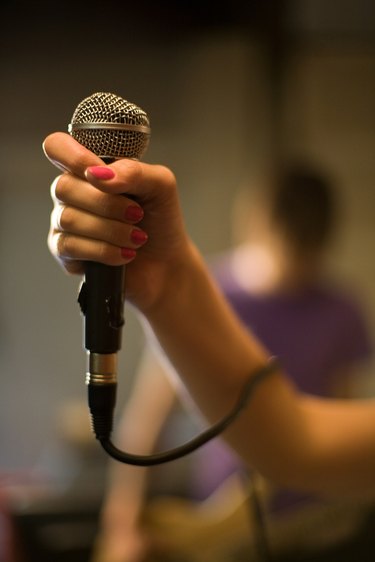
Both share a common XLR-type connector, but the anatomy of XLR microphone cables vs. XLR speaker cables is fundamentally different. No longer used for modern speaker hookups, XLR connectors are the professional standard for connection of microphone- and line-level audio equipment. Since some older speaker and amp models equipped with XLR connectors are still in service, it is important to use the correct cable to suit the application for proper sound and equipment damage prevention.
Microphone Cable Anatomy and Usage
Video of the Day
Microphone cable is a generic term for a "balanced" audio cable. This relatively thin cable of 18 to 24 gauge consists of two-conductor wires -- positive and negative -- plus a shielded ground wire fitted with three-pin XLR connectors for audio component interconnection. Microphones, power amplifier inputs, sound mixers, sound modification gear and some musical instruments use this cable type almost exclusively in professional applications. Balanced cable allows long run-lengths; no outside electronic interference due to the shield wire and the XLR connector allows universal plug and jack matching. These devices emit low voltages for which thin-gauge diameter balanced cable is suited.
Video of the Day
Speaker Cable Anatomy and Usage
Speaker cable is a generic term for unshielded two-conductor -- positive and negative -- cable fitted with connectors matching an amplifier speaker output with speaker input jacks. Power amplifiers are the last output device in any audio chain and provide speaker-level voltage to speakers to be converted into sound. This voltage is higher than that of other connected audio devices, negating the need for shield wire but requiring thicker diameter cable of 16 to 12 gauge, than that of balanced cable. Since speaker cables are neither balanced nor shielded, they are not suitable for connection of any other device regardless of connector. XLR connectors may be attached for compatibly with older equipment, but most speakers and amplifiers employ 1/4-inch phone plugs, "banana" plugs or the industry standard "Speakon" connector.
Microphone Cables for Powered Speaker Connections
The only exception for the use of XLR microphone cables for XLR speaker connections is when powered speakers are employed. These speakers contain internal amplifiers and speaker wiring, and are therefore considered a line-level device for which a standard, balanced XLR microphone cable is perfectly suited. Most every powered speaker is equipped with a balanced XLR input jack, with some including an additional unbalanced 1/4-inch jack for use with shielded musical instrument cables for direct connection of guitars, keyboards and other line-level gear requiring shielded unbalanced cable. Powered speakers should never be connected to another device with unshielded speaker cable, as the lack of shielding will produce audible humming and radio interference noise at distracting levels.
Dangers of Cable Substitution
The use of speaker cables to connect mic- or line-level audio devices will result in hum, radio interference noise, improper or non-operation and equipment damage in some cases. Connecting microphone cables to speakers can result in low sound output (due to the thin cable's inability to carry higher speaker-level voltage) and may cause severe damage to amplifiers. Always use labels or color-coding to identify different cable types that share common connectors.
- University of Southern California: Making Connections; Peter Elsea; 1996
- Apple Documentation: Audio Connectors and Signal Formats
- Techno-Fandom: Types of Audio
- Fender: Why Instrument Cables and Speaker Cables Aren't Interchangeable
- SoundFirst.com: A Brief History of the XLR Connector; Ray H. Rayburn; 2008
- Sweetwater: Cable Buying Guide
- Electronics2000: XLR Connectors; Simon Carter; 2011
- Roger-Russell.com: Speaker Wire, A History; Roger Russell
- Crutchfield: Speaker Wire: Choosing and Installing; Amanda Pollard: 2011